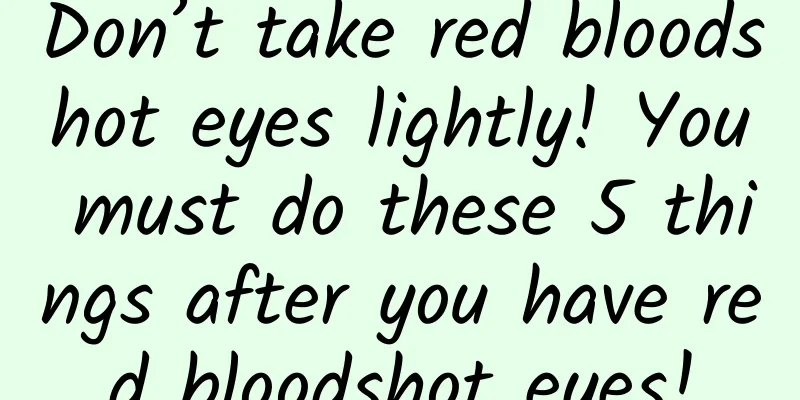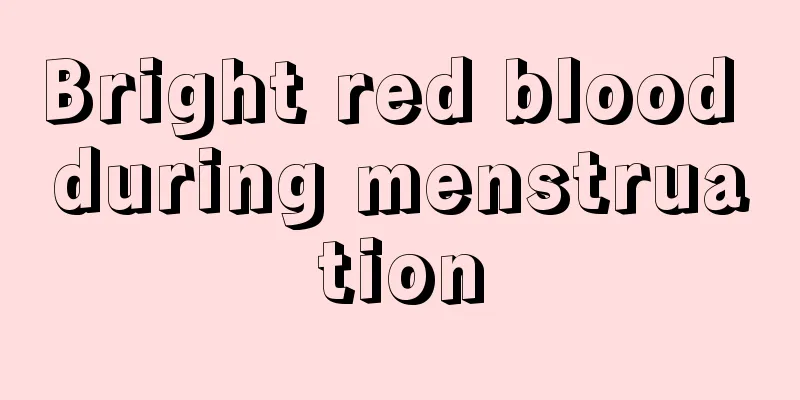Don’t take red bloodshot eyes lightly! You must do these 5 things after you have red bloodshot eyes!

|
When you look in the mirror one day, you may suddenly find that your eyes are full of red bloodshot, looking haggard and scary. Is it because you didn't get enough rest? Or is it because you are sick? You may have such questions. Why do we have red bloodshot eyes? What does it mean? What should we do? Today, let's talk about the things in the eyes. The structure of the eye Under normal circumstances, the surface of our eyeballs is covered with tiny blood vessels, which are usually not easy to detect. But when certain factors cause blood vessels to dilate, we can see obvious red bloodshot. The red bloodshot in the eyes is actually the result of dilation of conjunctival blood vessels, ciliary blood vessels or scleral blood vessels on the surface of the eyeball. Clinically, it can be divided into conjunctival congestion, ciliary congestion or scleral congestion. Conjunctiva: It is the outermost membrane of the white of the eyeball. It is a transparent film, like a "coat" of the eyeball, covering the surface of the white of the eyeball. There are many fine blood vessels on the normal conjunctiva to provide nutrition for the eyeball. Sclera: It is the "outer shell" of the eyeball, located under the conjunctiva (like the underwear inside a coat). It is a tough white fiber membrane that provides support and protection for the eyeball. Cornea: The black part of the eyeball that everyone sees. The surface of the black eyeball is the cornea. The cornea is transparent, like the window of the eye, like a piece of "glass". It helps light enter the eyeball so that we can see things clearly. Bloodshot eyes of patients with conjunctivitis How do red blood streaks occur? The main reasons for the occurrence of red blood streaks are: 1 Most commonly caused by excessive eye use Reading for a long time, looking at computers, mobile phones and other electronic devices, as well as staying up late, can cause dry and tired eyes, which in turn causes conjunctival blood vessel dilation and conjunctival congestion. 2 Local irritation If foreign objects such as shampoo, smoke, etc. enter the eyes, or if you rub your eyes with your hands, it may irritate the conjunctival blood vessels and cause them to dilate. 3 Allergic reactions When you are allergic to pollen, cosmetics, eye drops, etc., your eyes will have an immune response, leading to conjunctival congestion. 4 Inflammatory infection Severe eye inflammations such as conjunctivitis, keratitis, iridocyclitis, scleritis, and eye diseases such as glaucoma may cause conjunctival, ciliary or scleral congestion. Are red bloodshot eyes a sign of disease? Red bloodshot eyes are usually not an independent disease, but a manifestation of multiple eye problems or bad lifestyle habits. Here are some possible signs: 1 Eye fatigue After using your eyes for a long time or staying up late, your eyes are prone to red bloodshot, which is a clear sign of eye fatigue. Although eye fatigue itself does not directly damage your vision, it may cause dry eyes, myopia and other problems in the long run. 2 Conjunctivitis Conjunctivitis is a general term for inflammation of the conjunctiva, which can be caused by bacteria, viruses, allergies, etc. Typical symptoms of conjunctivitis include red eyes, itching, increased secretions, etc., among which red bloodshot eyes are one of the most intuitive manifestations. 3 Dry Eyes Dry eye is an eye disease caused by insufficient tear secretion or excessive evaporation. Common symptoms include dry eyes, soreness, foreign body sensation, etc. Patients with dry eye often have conjunctival vasodilation and the formation of red blood streaks. 4 glaucoma Glaucoma is a serious blinding eye disease whose early symptoms may not be obvious, but some patients will experience ciliary congestion, which manifests as dark red bloodshot, accompanied by decreased vision and eye pain. 5 Other eye diseases In addition to the above common diseases, red bloodshot may also appear in eye inflammations such as keratitis, iridocyclitis, and scleritis. These diseases are often accompanied by varying degrees of vision loss and eye discomfort symptoms. Ocular hyperemia caused by non-ulcerative sterile keratitis What should I do if there are red bloodshot eyes? If you find red bloodshot eyes, you don’t need to panic, but you can’t take it lightly. Here are some coping measures: 1 Take rest Avoid using your eyes continuously for long periods of time. Look into the distance or close your eyes for a few minutes every once in a while. Ensure adequate sleep and avoid staying up late. 2 Maintain eye hygiene Do not rub your eyes with your hands to avoid foreign matter entering your eyes. If you need to use cosmetics or eye drops, choose non-irritating products and be careful to clean your hands. 3 Using eye drops Choose appropriate eye drops for treatment under the guidance of a doctor. For patients with dry eyes, moisturizing eye drops such as artificial tears can be used; for inflammatory diseases such as conjunctivitis, antibiotics or antiviral eye drops are needed for treatment. 4 Adjust your lifestyle Maintain a light diet and avoid excessive intake of spicy and irritating foods. Exercise moderately to enhance physical fitness and immunity. Maintain a good mentality and emotional state and avoid excessive tension and anxiety. 5 Seek medical attention promptly If the red blood streaks persist or are accompanied by other symptoms such as decreased vision, eye pain, increased secretions, etc., you should seek medical attention and treatment in time. The doctor will develop a personalized treatment plan based on the patient's specific situation to ensure eye health. In short, although red blood streaks in the eyes are common, they cannot be ignored. Proper rest, maintaining good living habits, and timely medical examination and treatment can effectively alleviate and prevent the occurrence and development of red blood streaks. Let us pay attention to eye health and protect bright eyes! Planning and production Author: Liu Xiufen, deputy chief physician of ophthalmology, Bethune First Hospital, Jilin University Review丨Jin Xiuming, Deputy Director of the Ophthalmology Center, Zhejiang University Second Hospital |
>>: 5 habits that your stomach is afraid of, many people do them almost every day!
Recommend
At what age does a woman enter menopause?
Every woman has to go through menopause, which us...
What is the reason why frozen hairtail turns yellow? Can hairtail roe be eaten?
Hairtail is also called skirt hairtail, fat hairt...
comScore: Asia Pacific has become the world's largest social networking market
According to the latest report released by market...
Can pears reduce internal heat?
Many people have eaten pears. Pears are a very co...
What are the red spots on the pregnant woman's belly?
After our female friends become pregnant, many re...
How to maintain premature ovarian failure
The occurrence of premature ovarian failure will ...
What does depression do to the brain?
This article was reviewed by Zhao Wei, deputy chi...
If you love her, make her a beauty and blood-nourishing soup
My wife has been looking pale and weak in recent ...
Will dysmenorrhea get better after marriage?
Many women usually suffer from dysmenorrhea. Dysm...
What tests should be done at 16 weeks of pregnancy
The 16th week of pregnancy has entered the second...
The role of fallopian tube embolization
As the pace of work and life continues to acceler...
Wearing a hat can protect your heart? The truth is...
Myth "Wearing a hat can protect your heart!&...
How to remove lip hair from beard
Don’t you think that things like beards are only ...
Symptoms of dopamine deficiency in women
The amount of dopamine affects our mood changes. ...









